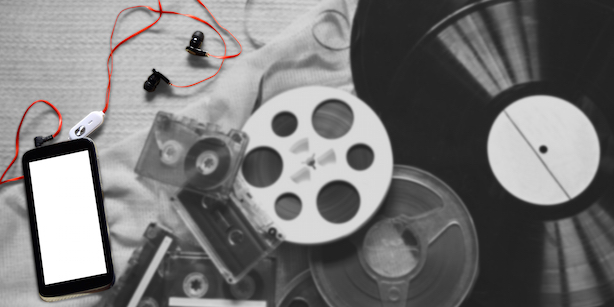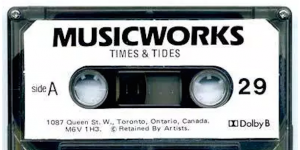 Music
Music
The evolution of musical formats
by Joe Smith-Engelhardt
March 24, 2016
Streaming services could be the format that saves the music industry or kills it.
The way we consume music has gone through too many changes to count over the years, constantly shifting the way artists, labels, and listeners think about releases.
In the early days of commercial music it was all about buying vinyl records. Whether it was 7″ singles or full length LPs, people wanted a physical copy because there was no other way to listen. Today, the music industry needs to create a new model that works for artists who are making literal pennies for their hard work since the internet has led to illegal downloads or streams.
The formats that musicians release their music on don’t always boil down to the way that we buy music, though. It also shapes how artists are choosing to release their music as the options have now become endless. Artists can release their music as a completely free or pay what you can digital download, or in more traditional formats that have been revamped and perfected over the years, like vinyl or cassettes.
Prior to the formats we use today people had the innovative phonograph made by none other than Thomas Edison back in 1877. Recordings were etched into metal cylinders that were wrapped in tinfoil until over a decade later when Edison started using all wax cylinders that could record new sounds, similar to a CD-R.
During the 1890s the transition to flat discs brought mass production with the possibility of having a master copy of a recording that could be easily reproduced instead of individually etching wax covered cylinders. The records were made of a shellac and came in different sizes for different lengths of recordings, effectively making wax cylinder recordings obsolete.
Audio formats wouldn’t see a large shift until after World War II when shellac records were replaced with vinyl, a much lighter and more durable material. This was one of the most groundbreaking developments in music formats as vinyl changed the standard speed of records from 78 rpm to 33 1/3 rpm, allowing a much longer recording length that let musicians record more than singles.
78 rpm vinyl was only able to hold up to three minutes of material so artists would release songs as collections that were put in sleeves resembling books, leading to the term “recording album.” Post World War II vinyl also saw the introduction of 45 rpm records which could hold two songs on each side and established EPs, or extended plays.
For decades to follow, record players were the standard for listening to music at home. That was until a Dutch technology company called Philips introduced one of the worst formats to ever release music on: the original cassette tape. In 1962, the technology was hard for people to adapt to and a short two years later cassettes were rare to see in music shops.
Only two years after the death of cassettes Bill Lear of the Lear Jet Corporation as well as Ford, General Motors, Ampex, Motorola and RCA developed the 8-track and brought back the use of magnetic tapes for releasing music. By the late ’60s nearly every Ford car came with an 8-track player in the dash and most car companies followed suit.
By the 1970s 8-track catalogues were as big as vinyl but it was only a decade after being introduced that 8-track would be made obsolete by new and improved cassette tapes once again. The 8-track will always go down as the first invention that let people listen to music in their cars that wasn’t from the radio.
The reason that cassettes took over as the best new format was that the tapes were small, portable and could now hold high quality sound unlike they did before 8-tracks. The smaller size led to Sony creating the Walkman and effectively ending the era of the 8-track. This was the very first thing that allowed people to take their music with them wherever they went. By 1983 cassette tapes had fully taken over and surpassed sales of vinyl for the very first time.
Cassettes were a fantastic way to enjoy music for decades even with other options available that most people choose today before even considering listening to a tape. Vinyl now seemed like a bulky, excessive format and compact discs weren’t very common at first. These were a luxury meant for the rich until the prices of CD players started to drop by the late 1980s.
The first album ever pressed to CD was ABBA’s 1981 album The Visitors, although the first CD ever released was Billy Joel’s 52nd Street. For the last few decades, CDs have been a mainstay of music production with nearly every release having a CD pressing.
One of the big draws of CDs for music fans was the new technology that scratch-protected the discs. CDs were much more forgiving than vinyl or other formats when it came to damage as well as reading the disc a few seconds ahead of where it was playing in case the disc skipped.
Technological advances have led to CD sales dropping over 30% in 2015 but they continue to steadily decline with the vinyl resurgence and popularity of streaming services. The format was one of the most effective throughout history and shaped how the music business was to grow for decades.
CDs started music fans’ digital collections but it was the introduction of the mp3 player that really started us down the rabbit hole of streaming services and illegal downloads. Although the mp3 player had been in development since 1986, mp3 support wasn’t something most computers had until 1997 when Microsoft incorporated it into its media players. Within a year, portable mp3 players were being mass produced.
From the introduction of the mp3 player came peer-to-peer file sharing websites, most notably Napster. Musicians and industry experts knew sites like Napster would cause a major shift in how the music industry would operate which sparked the famous Metallica vs. Napster lawsuit that ended the company less than two years after it began. Metallica had heard their song “I Disappear” on the radio when it was supposed to be released with the Mission: Impossible II soundtrack and didn’t take kindly to noticing that their entire discography was available for free.
Shortly after Metallica launched their lawsuit, Dr. Dre as well as the Recording Industry Association of America filed similar lawsuits and shut down Napster forever. This was clearly not the end of peer-to-peer file sharing sites, though, since musicians are still battling illegal downloading. Sites such as LimeWire, Madster and FrostWire would pop up too quickly for the music industry to control. Less and less music was being purchased which is something today that still needs to be addressed in a better way.
Digital downloads became a more legitimate business when Apple invented the iPod in 2001. Along with the iPod came iTunes and by 2003 Apple had started selling music with their online store. This completely shifted the revenue model that record labels had since now they could completely eliminate the manufacturing and shipping costs of physical copies of albums. Whether this is a good or bad thing is still up for debate, but regardless, digital downloads became a model that musicians could not avoid.
Although musicians can’t avoid digital downloads they have been pushing music collectors to get back to buying physical copies. Vinyl may have dropped off with the growing popularity of cassettes but in the last decade artists have been heavily promoting the revival of this format. In 2015 vinyl sales reached a 26-year high with over nine million records being sold in the first half of the year, compared to 14 million albums being sold across all of 2014.
The growing popularity of vinyl is mostly attributed to millennials with around half of record buyers today being under 25. The revival of vinyl has been great for smaller artists with the introduction of Record Store Day though vinyl sales only make up about 2% of music sales worldwide. Even if vinyl won’t save the music industry, it is still keeping the idea of collections alive and thriving. The Official Charts Company recognized this surge in vinyl sales last year by dedicating specific charts to vinyl LPs as well as singles.
Digital formats of music are still dominating over physical copies today. Streaming services have taken over consumers who want to have a service not far off from the idea of Netflix instead of buying individual albums or songs. It’s still unclear how streaming services will affect the music industry entirely because of how new the services are but it is clear that streaming is the way of the future.
In the last year subscriptions to streaming services have increased 39% where digital downloads have dropped 8%. A subscription to Spotify costs $120 per year or roughly the cost of 12 digital albums yet Spotify offers free use with ads. Spotify and other streaming services have been problematic. Numerous artists have shared photos of the pathetic pennies they get paid for when fans are streaming their material hundreds of thousands of times every month.
The music industry has been battling with fans not wanting to pay for music for decades. Streaming services could either be the format that saves the music industry or kills it, but it all depends on the direction companies will take with their revenue model. People are gravitating towards this method at an alarming rate so whether the music industry will find a way to make streaming work for everyone involved is a matter that only time will tell.










